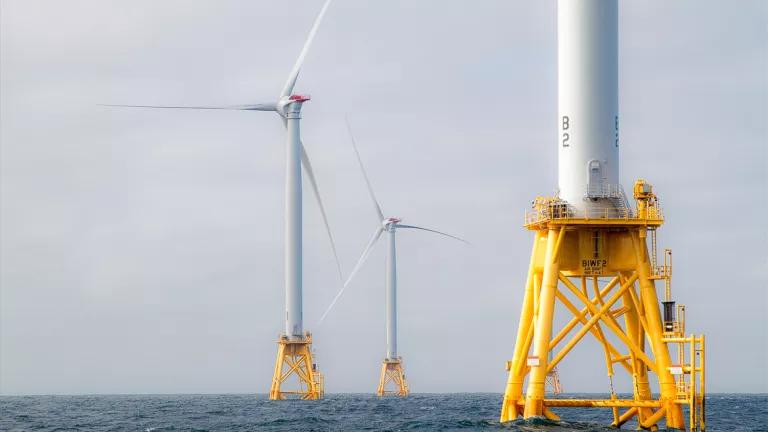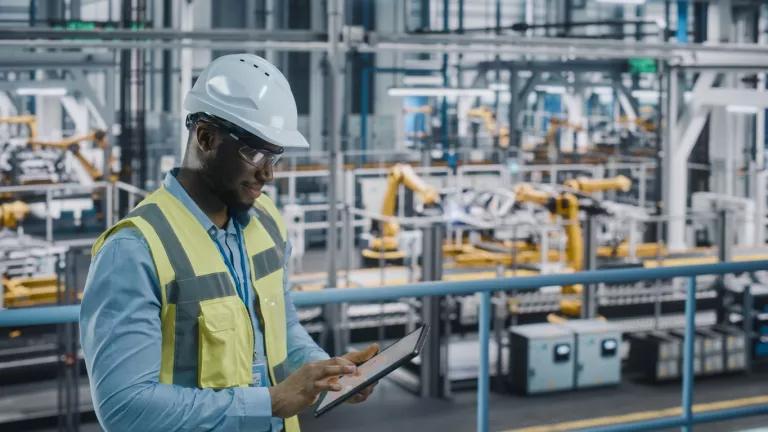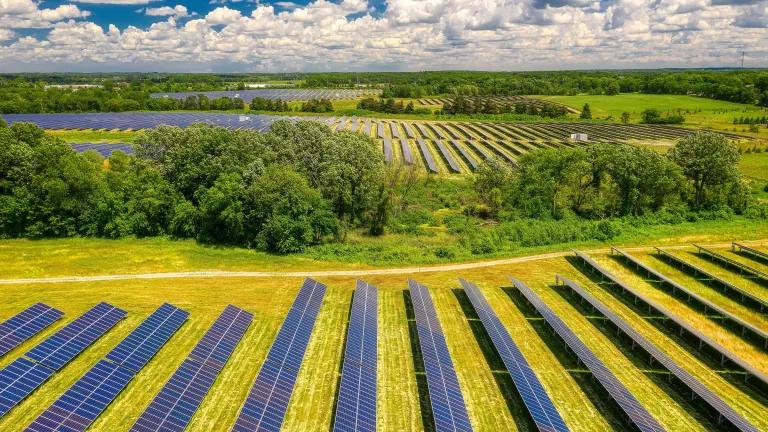Innovation Principles to Limit Global Temperature Rise to 1.5° Celsius
The Intergovernmental Panel on Climate Change recently released the third installment of its sixth assessment report, which once again sounded the alarm for rapid decarbonization before climate catastrophe becomes inevitable.

Block Island Wind Farm
Gary Norton, DOE
The Intergovernmental Panel on Climate Change (IPCC) recently released the third installment of its sixth assessment report—Climate Change 2022: Mitigation of Climate Change—which once again sounded the alarm for rapid decarbonization before climate catastrophe becomes inevitable. The report came out on the heels of President Biden’s fiscal year 2023 (FY23) budget request for the U.S. Department of Energy (DOE), and it examines the sources of global greenhouse gas (GHG) emissions along with the progress to date on climate change mitigation. The evidence laid out in the report is clear: The time for action is now. The next few years will be critical to limit warming below 1.5 degrees Celsius and will require: global GHG emissions to peak before 2025, the closing of investment gaps in adaptation and mitigation, and clear signaling from governments and the greater community for decarbonizing our economy.
The IPCC report highlights the need to more aggressively address fossil fuels and increase investments in clean energy and energy efficiency.
According to the IPCC report, average annual GHG emissions have continued to rise during the past decade and have been higher than in any previous decade. This is despite our efforts to reduce our GHG emissions through deployment of clean energy and improvements in technology. The figure below depicts the change in global GHG emissions from 1990 to 2019.

Figure 1. Global net anthropogenic GHG emissions (1990-2019)
The report goes even further, arguing that the policies and nationally determined contributions (NDCs) of today would make it likely that warming will exceed 1.5 degrees Celsius during this century because projected cumulative future GHG emissions over the lifetime of existing and planned fossil fuel infrastructure exceed the net emissions allowable for a future that limits warming to 1.5 degrees Celsius. To that end, it’s even more crucial for us to urgently and dramatically ramp up deployment of renewable energy and clean energy technologies.
The IPCC report also highlights the disparity between regional contributions to global GHG emissions. Least-developed countries and small island states have the lowest per capita emissions while the highest emitters are the most developed and wealthiest nations. For this reason, the U.S. government and DOE have a responsibility to be at the forefront of clean energy innovation and lead the global vanguard toward a more sustainable future.
Fortunately, there are positives in the IPCC report too. The price of clean energy technologies has fallen rapidly since 2010, and this has resulted in a sharp increase in adoption of these technologies. Costs for solar energy have fallen by 85 percent, wind energy by 55 percent, and lithium-ion batteries by 85 percent, while deployment has increased by more than 10 times for solar and 100 times for electric vehicles (EVs). Below is a figure illustrating some of these trends.

Figure 2. Unit cost reductions and use in some rapidly changing mitigation technologies
However, there is considerably more work to be done and investments to be made in clean energy technology and innovation. The report mentions that the full energy sector requires major transitions, including a sharp reduction in fossil fuel use, deployment of clean energy technology, switching to alternative energy carriers, and energy efficiency and conservation. Electricity systems powered mainly by renewable energy will be increasingly viable in the future, but there are applications that currently cannot be electrified—such as aviation and heavy industry—and will require substantial investment and innovation this decade. Below are some of the challenges, investment gaps, and opportunities for innovation and decarbonizing our economy, many of which are elaborated upon in the report:
- Transportation
- Assessed scenarios show that without intervention, carbon dioxide (CO2) emissions from transport could grow by 16 percent to 50 percent by 2050. Literature reviewed also indicated that fuel and technology shifts are crucial to decarbonization.
- Land-based, long-range, heavy-duty trucks can be decarbonized but face challenges regarding driving range, capital and operating costs, infrastructure availability, fuel cell durability, and high energy consumption.
- Decarbonization options for shipping and aviation still require research and development, although green hydrogen, advanced biofuels, ammonia, and synthetic fuels are emerging as potential decarbonization options.
- Buildings
- GHG emissions from buildings were equivalent to 21 percent of global emissions (and closer to 40 percent in the United States) when accounting for off-site generation of electricity). However, decarbonization of buildings is constrained by limited financial flows as well as technology barriers (e.g., heat pumps are expensive and lack a developed market or policy solutions for commercial viability), education barriers (e.g., contractors, homeowners, and business owners are typically unaware of the benefits of heat pump technology), and the lack of incentives to improve efficiency of or electrification of existing buildings.
- Industry
- Costs and emissions reduction potentials in industry, especially heavy industry, will rely on innovation, commercialization, and market uptake policies. The report suggests that current technologies require 5 to 15 years of intensive innovation, commercialization, and policy to ensure uptake.
- Several technological options exist for very low- to zero-emissions steel, but their success will be reliant on integrated material efficiency, recycling, and policies to decarbonize production processes. Existing facilities will also need to be retrofitted.
- The report calls for innovation and commercialization policies to significantly reduce cement and concrete emissions. Higher material efficiency efforts, as well as replacing cement with other materials such as ground limestone and calcined clays, could reduce emissions significantly. Nevertheless, the world will continue to rely on cement as the key binding agent in concrete as countries industrialize and replace aging infrastructure. The report notes that “until a very low GHG emissions alternative binder to Portland cement is commercialized—which is not anticipated in the near to medium term—CCS [carbon capture and storage] will be essential for eliminating the limestone calcination process emissions for making clinker, which currently represent 60 percent of GHG emissions in best available technology plants.” Our experts at NRDC talk about how we can decarbonize cement production with current processes here.
- Other
- Carbon dioxide removal is imperative to achieve net-zero CO2 and GHG emissions and limit warning to below 1.5 degrees Celsius.
Looking toward 2030 and beyond
The IPCC’s report on mitigation of climate change reiterates the dire urgency of decarbonizing the economy, and certain principles can be taken away from the report to guide our investments and innovation efforts for the future.
- We need to significantly ramp up investments in, and deployment of, all clean energy technologies and renewable energy, but more attention needs to be given to sectors that have received lesser focus in the past, such as buildings, vehicles, and industry. The industrial sector is responsible for roughly one-third of U.S. emissions, but research and development in this sector has been historically underfunded compared to others. The buildings and transportation sectors also pose huge opportunities for decarbonization through electrification and improvements in energy efficiency.
- The investment and technical gaps in these sectors, and more broadly clean energy, can only be bridged by greater investment in the full innovation life cycle. Although we should be leveraging all existing decarbonization options to get us to our 2030 climate goals, reaching net-zero emissions by 2050 will require a wider range of strategies and technologies and force us to anticipate future challenges, such as the integration of very high shares of renewables into the electric grid. Furthermore, we should be thinking about innovation from a more holistic perspective, starting with basic, applied research, all the way up to demonstration and commercialization of technologies. The recent restructuring of the DOE, which established two under secretaries—one focused on fundamental science and clean energy innovation and the other on demonstrating and deploying clean infrastructure—aims to strengthen the link between research and commercialization and is a great example of the holistic approach we need.
- Our economy’s clean energy transition needs to be done with equity and environmental justice at the forefront of our priorities. The IPCC report notes that the 10 percent of households with the highest per capita emissions contribute 34 percent to 45 percent of global consumption-based household GHG emissions, while the bottom 50 percent contribute only 13 percent to 15 percent. Just as we’ve seen inequities between countries in terms of GHG emissions, there have also been inequities within wealthier nations such as the United States. If we don’t consider equity and justice in our clean energy future, we will perpetuate the inequities of today and make the same mistakes we made in the past.



